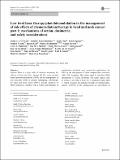Low level laser therapy/photobiomodulation in the management of side effects of chemoradiation therapy in head and neck cancer: part 1: mechanisms of action, dosimetric, and safety considerations
Author(s)
Elad, Sharon; Barasch, Andrei; Genot, Marie-Thérèse; Lansaat, Liset; van der Brink, Ron; Arnabat-Dominguez, Josep; van der Molen, Lisette; Jacobi, Irene; van Diessen, Judi; de Lange, Jan; Bensadoun, René-Jean; Zecha, Judith A. E. M.; Raber-Durlacher, Judith E.; Nair, Raj G.; Epstein, Joel B.; Sonis, Stephen T.; Migliorati, Cesar A.; Milstein, Dan M. J.; Smeele, Ludi E.; Schubert, Mark M.; Hamblin, Michael R; ... Show more Show less
Download520_2016_Article_3152.pdf (411.7Kb)
PUBLISHER_POLICY
Publisher Policy
Article is made available in accordance with the publisher's policy and may be subject to US copyright law. Please refer to the publisher's site for terms of use.
Terms of use
Metadata
Show full item recordAbstract
Purpose:
There is a large body of evidence supporting the efficacy of low level laser therapy (LLLT), more recently termed photobiomodulation (PBM), for the management of oral mucositis (OM) in patients undergoing radiotherapy for head and neck cancer (HNC). Recent advances in PBM technology, together with a better understanding of mechanisms involved, may expand the applications for PBM in the management of other complications associated with HNC treatment. This article (part 1) describes PBM mechanisms of action, dosimetry, and safety aspects and, in doing so, provides a basis for a companion paper (part 2) which describes the potential breadth of potential applications of PBM in the management of side-effects of (chemo)radiation therapy in patients being treated for HNC and proposes PBM parameters.
Methods:
This study is a narrative non-systematic review.
Results:
We review PBM mechanisms of action and dosimetric considerations. Virtually, all conditions modulated by PBM (e.g., ulceration, inflammation, lymphedema, pain, fibrosis, neurological and muscular injury) are thought to be involved in the pathogenesis of (chemo)radiation therapy-induced complications in patients treated for HNC. The impact of PBM on tumor behavior and tumor response to treatment has been insufficiently studied. In vitro studies assessing the effect of PBM on tumor cells report conflicting results, perhaps attributable to inconsistencies of PBM power and dose. Nonetheless, the biological bases for the broad clinical activities ascribed to PBM have also been noted to be similar to those activities and pathways associated with negative tumor behaviors and impeded response to treatment. While there are no anecdotal descriptions of poor tumor outcomes in patients treated with PBM, confirming its neutrality with respect to cancer responsiveness is a critical priority.
Conclusion:
Based on its therapeutic effects, PBM may have utility in a broad range of oral, oropharyngeal, facial, and neck complications of HNC treatment. Although evidence suggests that PBM using LLLT is safe in HNC patients, more research is imperative and vigilance remains warranted to detect any potential adverse effects of PBM on cancer treatment outcomes and survival.
Date issued
2016-03Department
Institute for Medical Engineering and Science; Harvard University--MIT Division of Health Sciences and TechnologyJournal
Supportive Care in Cancer
Publisher
Springer-Verlag
Citation
Zecha, Judith A. E. M., Judith E. Raber-Durlacher, Raj G. Nair, Joel B. Epstein, Stephen T. Sonis, Sharon Elad, Michael R. Hamblin, et al. “Low Level Laser Therapy/photobiomodulation in the Management of Side Effects of Chemoradiation Therapy in Head and Neck Cancer: Part 1: Mechanisms of Action, Dosimetric, and Safety Considerations.” Supportive Care in Cancer, vol. 24, no. 6, March 2016, pp. 2781–2792.
Version: Author's final manuscript
ISSN
0941-4355
1433-7339